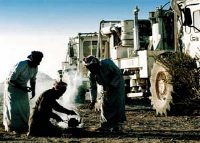Middle East: Saudi Arabia
August 2000 Vol. 221 No. 8 International Outlook MIDDLE EAST Disciplined output pays off Windfall oil revenues and conservative spending have given the new mi
MIDDLE EASTDisciplined output pays offWindfall oil revenues and conservative spending have given the new millenium a good start. However, increasing domestic energy demand is affecting oil exports, another reason for national oil companies to emphasize the development of natural gas projectsAll countries, except Iran and Turkey, by Dr. A. F. Alhajji, Contributing Editor Saudi ArabiaThis year witnessed Saudi Arabia’s rebirth as the main player in global oil markets, as the Gulf superpower, as a chief of diplomacy, and as an investment hot spot. Saudi Arabia has orchestrated major production cuts since 1998. When oil prices rose too high, it took the lead role in convincing OPEC members to increase output earlier this year. Recently, the kingdom said it might increase output further by 500,000 bopd. The kingdom passed a series of reforms and new laws, to boost the economy, attract foreign investment, and increase the private sector’s role. A new foreign investment law approved last April offers sweeping incentives to attract long-term capital infusion. Foreign investment tax rates are reduced 30%, to match tax rates paid by Saudi firms.
The government established the Supreme Petroleum and Mineral Affairs Council. It is headed by King Fahd and includes senior cabinet members. The council has a wide range of powers to approve and define petroleum and gas policies, specify production levels, approve pricing plans, and draft Saudi Aramco’s general policy. Some council members comprise the Saudi Ministerial Oil Committee that was formed in December 1998. The panel reviews project proposals submitted by a select number of international oil companies. Saudi Aramco continued "Saudizing" various jobs that were traditionally held by foreigners, achieving nearly 85% Saudization of its 54,000-plus workforce. Aramco also launched a new corporate identity and logo. Exploration. Aramco announced two major gas / condensate discoveries in the eastern province at the end of 1999. They hold reserves of up to 6 billion bbl of condensate (51°API) and 4 Tcf of natural gas. Both are near Ghawar oil field: at Niban, 56 mi southeast of Ghawar, and at Shaden, 37 mi southwest of Ghawar. Earlier this year, Aramco struck a sweet gas find at the al-Manjurah 1 well. It was the seventh discovery in the southern Ghawar area, in Aramco’s stepped-up, gas exploration campaign. This was followed in July by a gas find at the al-Ghazal prospect that flowed 17 MMcfgd and 2,500 bcpd, about 62 mi west of Haradh. Aramco will drill appraisals and additional wildcats, to further identify the new reserves. Aramco plans to invest $45 billion over the next 25 years on gas infrastructure. Recent comments by Amir Faisal Ibn Turki, advisor at the Ministry of Petroleum and Mineral Affairs, indicate that Saudi Aramco has replenished depleted reserves with new discoveries, thus maintaining total proven oil reserves at about 260 billion bbl.
Drilling/development. Given a reduced OPEC output ceiling, plus recent new oil finds, Aramco had the luxury of conducting a more leisurely drilling campaign. Thus, wells drilled declined 21%. This year, drilling should increase 2.7%. Again, Aramco’s excess capacity may have influenced the decision not to drill more wells. Recent reports indicate that Aramco’s strategy is to maintain productive capacity at 10 million bopd, as it has done for the past 15 years. Aramco maintains its additional capacity via a number of options, such as water injection, well workovers and the drilling of new wells. However, Aramco can increase its production – to as high as 12 million bopd – within six to 12 months. Investment continues in lighter crude oil reserves, especially in Shaybah field in the Empty Quarter. Late last year, Aramco announced a major gas development program to produce at least 1.6 Bcfd of associated gas in two phases at Khuff fields. The gas will be used in electricity generation. Last May, Aramco awarded two contracts, to replace three key electrical generators at Abqaiq plants – the firm’s main onshore, oil processing operation – to ensure reliable operations. The plant processes about 6 million bopd. In addition, expansion of the Master Gas System (MGS) processing facilities at the Uthmaniyah and Berri plants has finished. Construction of new MGS facilities and expansion of existing infrastructure is underway at the Shedgum plant. Construction is also underway at Hawiyah and Haradh gas processing plants to increase MGS sales gas capacity by 122%, when these projects complete in 2001 and 2003. Production. OPEC’s lower quotas reduced Saudi output by 6.6% in 1999. Saudi Arabia produced an average 7.8 million bopd and 666,000 bpd of NGLs. Oil production did not change during first-quarter 2000, but OPEC’s decision to increase output last March boosted Saudi’s level to 8.1 million bpd in April, a 3% increase. Recent production is estimated at between 8.35 million and 8.6 million bopd. Saudi is expected to continue this level unless oil prices drop below $22/bbl. Aramco’s reserves stood at 259.1 billion bbl of oil and 204 Tcf of gas,
as of January 2000, including 68 Tcf of non-associated gas. Recent discoveries may have increased reserves
slightly. |
- Applying ultra-deep LWD resistivity technology successfully in a SAGD operation (May 2019)
- Adoption of wireless intelligent completions advances (May 2019)
- Majors double down as takeaway crunch eases (April 2019)
- What’s new in well logging and formation evaluation (April 2019)
- Qualification of a 20,000-psi subsea BOP: A collaborative approach (February 2019)
- ConocoPhillips’ Greg Leveille sees rapid trajectory of technical advancement continuing (February 2019)




